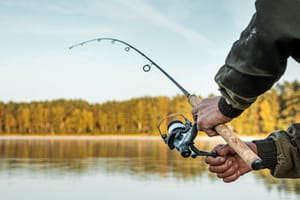Fishing is both an art and a science, requiring skill, patience, and the right equipment. One critical aspect of a fishing reel that often puzzles anglers is the gear ratio. Understanding what gear ratio means on a fishing reel can significantly enhance your fishing experience by allowing you to choose the right reel for your fishing style and the species you're targeting.
Key Takeaways:
- Gear ratio determines the speed and power of a fishing reel.
- A higher gear ratio means faster retrieval but less power, while a lower gear ratio means more power but slower retrieval.
- Knowing the right gear ratio for your fishing needs can improve your catch rate and overall fishing efficiency.
The Basics of Gear Ratio
When you're browsing through fishing reels, you'll often come across specifications that mention the gear ratio. But what does gear ratio mean on a fishing reel? Simply put, the gear ratio refers to the number of times the bail rotates around the spool with a single turn of the reel handle. For example, a gear ratio of 5:1 means that for every turn of the handle, the bail goes around the spool five times.
This ratio is a result of the relationship between the drive gear attached to the handle and the pinion gear that turns the spool. A higher gear ratio implies that the reel can retrieve line faster, which is beneficial when you need to quickly bring in your line. Conversely, a lower gear ratio will retrieve line more slowly but with more torque, making it easier to reel in heavier fish.
High Gear Ratios: Speed Over Power
High gear ratios, typically considered to be around 6:1 or above, are designed for situations where speed is crucial. These reels are excellent for techniques that require quick line retrieval, such as when working with topwater lures or when you need to keep up with a fast-moving fish. They allow you to reel in slack line rapidly, maintaining tension and control.
However, the trade-off for this speed is power. With a high gear ratio, you'll find it more challenging to reel in larger, heavier fish, as the reel is not optimized for torque. This means you'll have to work harder to fight the fish, which can be tiring and may even result in lost catches if the fish is particularly strong.
Low Gear Ratios: Power Over Speed
On the other end of the spectrum, low gear ratios, which are around 4:1 or lower, offer more cranking power. These reels are ideal for deep water fishing, heavy lures, or targeting large species that require a lot of power to reel in. The lower gear ratio makes it easier to handle the resistance of a big fish, giving you the mechanical advantage to pull it without exerting excessive force.
While low gear ratio reels excel in power, they lack in retrieval speed. This means that if you're trying to cover a lot of water or need to reel in quickly for another cast, a low gear ratio reel might not be the best choice. It's all about balancing the need for power with the need for speed.
Mid-Range Gear Ratios: The Best of Both Worlds
Mid-range gear ratios, typically around 5:1, offer a balance between speed and power. These reels are versatile and can be used in a variety of fishing situations. Whether you're casting crankbaits, spinnerbaits, or using live bait, a mid-range gear ratio can handle it all with moderate efficiency.
While they may not excel in any particular aspect like their high or low ratio counterparts, mid-range gear ratio reels are a great choice for anglers who want a "jack of all trades" reel that can adapt to different fishing conditions and techniques.
Gear Ratio and Line Recovery
Another aspect to consider when discussing gear ratios is line recovery. This refers to the amount of line that is reeled in with each turn of the handle. A reel with a high gear ratio will have a higher line recovery rate, meaning you can retrieve more line faster. This is particularly useful when you're trying to keep up with a fish that's swimming towards you.
However, line recovery also depends on the size of the spool. A larger spool will retrieve more line per handle turn than a smaller spool, even if they have the same gear ratio. Therefore, when comparing reels, it's important to consider both the gear ratio and the spool size to get an accurate idea of the reel's line recovery capabilities.
Choosing the Right Gear Ratio for Your Fishing Style
Selecting the right gear ratio for your fishing reel is crucial for optimizing your fishing experience. If you're a beginner, starting with a mid-range gear ratio might be the best option as it offers flexibility. As you gain more experience and refine your fishing techniques, you may want to invest in reels with different gear ratios to suit specific scenarios.
For instance, if you enjoy fishing with buzzbaits or spinnerbaits, a higher gear ratio reel would be beneficial. Conversely, if you're into bottom fishing or using swimbaits, a lower gear ratio reel might be more appropriate. It's all about matching the gear ratio to your preferred fishing methods and the species you're targeting.
Maintenance and Longevity of Gear Ratios
Maintaining your fishing reel is essential for preserving its gear ratio performance. Regular cleaning and lubrication of the gears can prevent wear and tear, ensuring that the reel continues to function smoothly. It's also important to avoid overloading your reel with a catch that's too heavy for its design, as this can strain the gears and reduce the reel's lifespan.
By taking proper care of your fishing reel and using it within its intended limits, you can maintain an optimal gear ratio performance for many fishing trips to come.
Summary
The gear ratio of a fishing reel is a key factor that determines its retrieval speed and cranking power. High gear ratios are great for speed, low gear ratios for power, and mid-range gear ratios offer a balance of both. Understanding what gear ratio means on a fishing reel and choosing the right one for your fishing style can greatly enhance your fishing efficiency and enjoyment. Remember to maintain your reel properly to ensure its gear ratio performs well over time. Looking for the best spinning reel for walleye? Check out our top 5 for 2024!
FAQ Section
Q1: Can I use a high gear ratio reel for all types of fishing? A1: While you can use a high gear ratio reel for various types of fishing, it's best suited for techniques that require fast line retrieval. For fishing that demands more power to reel in heavy fish, a lower gear ratio may be more appropriate.
Q2: How does spool size affect line recovery? A2: Spool size affects line recovery because a larger spool will retrieve more line per handle turn than a smaller spool, even if they have the same gear ratio. It's important to consider both the gear ratio and spool size when evaluating a reel's line recovery capabilities.
Q3: What maintenance is required to keep a fishing reel's gear ratio in good condition? A3: To maintain a fishing reel's gear ratio, regularly clean and lubricate the gears to prevent wear and tear. Also, avoid overloading the reel with catches that exceed its weight capacity, as this can strain the gears and reduce the reel's lifespan.



